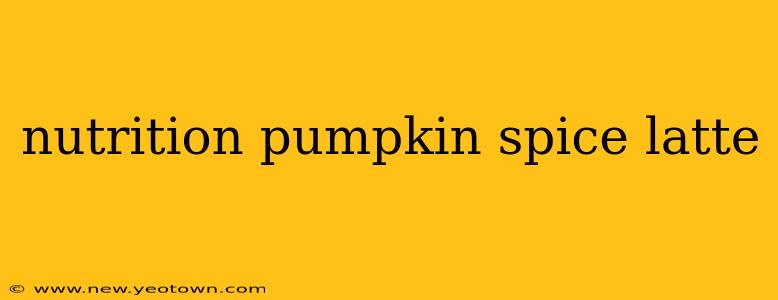Ah, the pumpkin spice latte (PSL). The quintessential fall beverage, a warm hug in a cup, the aroma alone conjuring images of crisp leaves and cozy sweaters. But beyond the delightful taste and seasonal charm lies a question many PSL aficionados ponder: what's the nutritional breakdown of this beloved drink? Let's delve into the creamy, spiced depths and uncover the nutritional truth behind your favorite autumnal indulgence.
What are the main ingredients in a pumpkin spice latte?
The core ingredients typically include espresso, steamed milk (often whole milk), pumpkin spice syrup, and whipped cream. The pumpkin spice syrup is where things get interesting; it's usually a concoction of sugar, water, pumpkin puree (often a surprisingly small amount), various spices (cinnamon, nutmeg, ginger, cloves), and sometimes artificial flavors and colors. The whipped cream adds another layer of sweetness and fat. Variations exist between coffee shops, but this is a general representation.
How many calories are in a pumpkin spice latte?
This greatly depends on the size and the specific coffee shop. A grande (medium) PSL from a popular coffee chain can easily clock in around 380-400 calories. This calorie count can significantly increase depending on the milk choice (whole milk contributes more calories than skim or non-dairy alternatives) and extra add-ins like extra whipped cream or syrups. Remember, those seemingly small extras add up quickly!
Is a pumpkin spice latte healthy?
Let's be honest: a pumpkin spice latte isn't exactly a health food. The high sugar content from the syrup is a primary concern. The added fats from the whole milk and whipped cream contribute to the calorie count. While the pumpkin puree does offer a small amount of vitamins and antioxidants, the overall nutritional profile is dominated by sugar and calories. Occasional enjoyment is fine, but making it a daily habit isn't conducive to a balanced diet.
What are the health benefits of pumpkin spice latte ingredients?
While the overall PSL isn't a health powerhouse, let's look at the individual components. Pumpkin itself contains vitamin A, beta-carotene, and fiber. The spices like cinnamon are linked to potential blood sugar regulation benefits and possess antioxidant properties. However, these benefits are significantly diluted by the added sugar and fat in a typical PSL.
How can I make a healthier pumpkin spice latte at home?
The good news is you can enjoy the deliciousness of a PSL while making it healthier! Making it at home allows for complete control over ingredients. Use unsweetened almond milk or skim milk instead of whole milk, reduce the amount of syrup dramatically, opt for sugar-free syrups or natural sweeteners like maple syrup in moderation, and perhaps even try homemade pumpkin puree for better control of quality. You can significantly reduce the calorie and sugar content by making these simple swaps.
Are there sugar-free pumpkin spice latte options?
Yes, many coffee shops offer sugar-free syrups as a substitution. However, be aware that these often contain artificial sweeteners, which some individuals prefer to avoid. Making your PSL at home gives you the ultimate control over sweetness levels, allowing you to experiment with natural sweeteners or even eliminate added sugars entirely.
What are the best pumpkin spice latte alternatives?
If you're looking for a healthier and lower-calorie alternative, consider a spiced chai tea latte with almond milk, a pumpkin spice smoothie made with real pumpkin and minimal added sugar, or simply enjoying a warm cup of black coffee with a sprinkle of pumpkin pie spice. These alternatives offer the cozy fall flavors without the hefty calorie and sugar load.
In conclusion, the pumpkin spice latte is a delicious treat to enjoy in moderation. Understanding its nutritional content empowers you to make informed choices about your consumption, whether opting for a healthier homemade version or embracing lower-calorie alternatives. Happy sipping!

